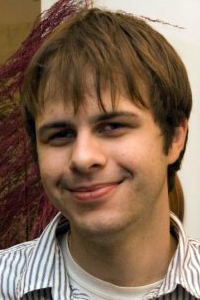What's New?
The 2010-2011 Beckman Scholars: Danny Tabor
| Faculty Mentor: Professor John F. Stanton Length of term: Summer 10, Fall 10, Spring 11, Summer 11 Honors & Awards:University Honors (Fall 07, Spring 08, Fall 08, Spring 09, Fall 09, Spring 10); National Merit Scholarship (2007); Freshman Research Initiative Summer Fellowship (2008); Dr. Norman Hackerman Endowed Scholarship (2009); Eva Stevenson Woods Endowed Presidential Scholarship (2009); William C. Gardiner Memorial Fund Scholarship (2009); Signature Science Award for Excellence in Chemistry Research (Spring 10); Hircshfelder Prize in Theoretical Chemistry, University of Wisconsin--Madison (2012). Publications:D.P. Tabor, M.E. Harding, T. Ichino and J.F. Stanton “High Accuracy Extrapolated Ab Initio Thermochemistry of the Vinyl, Allyl and Vinoxy Radicals” J. Phys. Chem. A, in press (2012). Where is he now? Graduated with Bachelor of Science (Chemistry) with Honors, with Special Departmental Honors in Chemistry, May 2011. Danny is currently at graduate school in the Department of Chemistry at U Wisconsin at Madison. How can I contact him? dtabor at chem.wisc.edu |
 |
Beckman research project in the Stanton group
Calculation of enthalpies of formation via isodesmic and hypohomodesmotic reaction schemes
An accurate determination of thermochemical parameters such as the enthalpy of formation of molecules is critical to the understanding of many types of reactions, including those of combustion and atmospheric processes. Many current schemes for high-accuracy calculations of the enthalpies of formation are dependent on the calculation of the atomization energy of the molecule of interest. Although the most sophisticated of such schemes are capable of calculating the enthalpies of formation to a high accuracy (< 1 kj mol-1), these protocols can only be applied to relatively small molecules due to its high computational cost.
The problems associated with calculating the enthalpy of formation for larger molecules can be largely simplified by calculating the enthalpy change for reactions that are not atomization reactions. In the current context are two classes of reactions: isodesmic reactions and the recently defined hypohomodesmotic reactions. Isodesmic reactions are those that maintain the same number of bonds of each type on each side of the reaction. For hydrocarbons, hypohomodesmotic reactions preserve both hybridization and the number of carbon atoms that are bound to a given number of hydrogen atoms on each side of the reaction. The reaction enthalpy for these classes of reaction can be accurately computed at a much lower level of theory than is necessary for atomization reactions due to cancellation of systematic errors in the computation.
For any given molecule, isodesmic and hypohomodesmotic reactions can be constructed using a set of molecules (synthons), which constitute a set of fundamental reactants and products. The scheme is to construct the unique reaction where the molecule of interest is combined with a subset of the fundamental reactants to form a subset of the fundamental products. If the thermochemistry of the synthons is accurately known, then it is possible to calculate thermochemical parameters for an arbitrary molecule using computational methods that are both simple and widely available.
The set of synthons is dependent on the type of reaction being considered (isodesmic or hypohomodesmotic) and the number of different types of atoms that are in the molecule under study. The thermochemical parameters of the synthons can be obtained accurately using the atomization scheme. The goal is to compute the enthalpy of formation for the synthons associated with the organic chemistry of molecules containing carbon, hydrogen, and oxygen. This will allow the enthalpy of formation to be calculated for many larger molecules that play critical roles in atmospheric chemistry, combustion reactions, and processes involving reactive intermediates.
Created and maintained by Ruth Shear. Comments to author at DrRuth@mail.utexas.edu
Created Wed Jun 6th 2007. Last modified Mon, Mar 10, 2014.